Reviving Iowa’s Agricultural Heritage: Vintage Tractor Plowing Event Unites Central City Community
“The vintage tractor plowing event in Central City, Iowa showcased pre-1960 machinery working on 25 acres of farmland.”
As we step back in time to witness a remarkable display of vintage farm equipment in action, we’re transported to a unique agricultural event that recently took place in Central City, Iowa. This old-time farming tradition brought together antique tractors and moldboard plows, working in harmony to cultivate 25 acres of farmland, recreating the community spirit of yesteryear. In this comprehensive exploration of America’s rural roots, we’ll delve into how these vintage machines and equipment once shaped the heartland and examine the evolution of farming technology that has led us to where we are today.
The Heart of Iowa’s Agricultural Heritage
Central City, a charming town nestled in the heart of Iowa, recently became the stage for a captivating journey through time. On a crisp Saturday morning, just east of the city limits, a group of vintage farm enthusiasts gathered at the Lloyd H. Brown Farm for an old-time plowing bee. This event wasn’t just a demonstration; it was a living, breathing tribute to the agricultural practices that built this nation.
From 9 a.m. to noon, the air was filled with the rhythmic chugging of engines as around a dozen pre-1960 antique tractors and moldboard plows worked in unison. These machines, lovingly restored and maintained, tilled the earth with a precision that harkened back to a time when farming was as much an art as it was a science.

A Tradition of Community and Cooperation
The event, held at 1361 Sawyer Road, drew attention from locals and visitors alike. Many followed the marked path off Jordans Grove Road to reach the field, where rows of restored tractors chugged across the land. This nostalgic scene served as a powerful reminder of the days when horsepower meant real horses — or the early machines that replaced them.
Jim Greif, the tenant of the Lloyd H. Brown Farm Museum, explained the significance of such gatherings: “Years ago, when a farmer would get sick, or something like that, or have a heart attack, or whatever, the neighbors would all come together. And this is a little bit reminiscent of that.” While this particular event wasn’t organized out of necessity, it beautifully captured the essence of rural community cooperation that has long been a hallmark of Iowa’s farming culture.
The Evolution of Iowa Farming Equipment (1900-1960)
| Year | Equipment Type | Key Features | Impact on Farming |
|---|---|---|---|
| 1900-1910 | Horse-drawn Plow | Single bottom, manual operation | Limited acreage plowed per day, labor-intensive |
| 1920s | Fordson Tractor | Steel wheels, 20 horsepower | Increased efficiency, reduced reliance on draft animals |
| 1930s | John Deere Model A | Rubber tires, power take-off | Improved traction, versatility in field operations |
| 1940s | Farmall M | Row-crop design, hydraulic system | Enhanced precision in planting and cultivation |
| 1950s | John Deere 70 | Diesel engine, power steering | Increased power and ease of operation |
| 1960 | International 460 | 3-point hitch, live hydraulics | Greater implement control, improved productivity |
Celebrating Historic Farming Practices
The Central City event was more than just a display of antique machinery; it was a hands-on history lesson that honored farming heritage and highlighted the importance of community in agricultural life. Visitors marveled at the pre-1960 machinery demonstrating historic farming practices, offering a glimpse into Iowa’s rich agricultural history.
For many of the participants, it was a chance to reconnect with the work they once knew and to share their knowledge with a new generation. The event showcased farmland preparation techniques from a bygone era, allowing enthusiasts and curious onlookers to witness firsthand how these vintage machines shaped the fields that feed America.
The Role of Moldboard Plows in Shaping Iowa’s Landscape
Central to the event were the moldboard plows, an implement that has been fundamental to Iowa’s agricultural development. These plows, designed to turn over the soil completely, were crucial in preparing fields for planting. The demonstration of moldboard plow techniques at the event highlighted how farmers of the past cultivated their land, creating the fertile fields that have made Iowa an agricultural powerhouse.
As we watched these vintage tractors pull moldboard plows across the fields, creating neat rows reminiscent of a time long past, we couldn’t help but reflect on the technological advancements that have transformed farming. Today, precision agriculture tools like those offered by Farmonaut provide farmers with satellite-based crop health monitoring and AI-driven advisory systems, revolutionizing the way we approach field preparation and crop management.
The Community Spirit of Farming Events
“Central City’s agricultural heritage event united the community to recreate farming practices from over 60 years ago.”
The plowing bee in Central City was more than just a demonstration of old equipment; it was a celebration of the community spirit that has long been the backbone of rural life. In the past, such events were often organized to support families facing hardship, with neighbors coming together to prepare fields for planting when a farmer was ill or unable to work.
While this particular gathering was purely for enjoyment, it paid tribute to that legacy of community and cooperation. The event drew people from all walks of life, from seasoned farmers to curious city dwellers, all united by a shared interest in Iowa’s agricultural roots.

Bridging the Past and Present of Iowa Agriculture
As we witnessed the vintage tractors and plows at work, it was impossible not to draw comparisons to modern farming practices. The event served as a powerful reminder of how far agricultural technology has come, while also highlighting the enduring importance of community and tradition in rural life.
Today’s farmers benefit from advanced technologies that would have seemed like science fiction to their predecessors. For instance, Farmonaut’s crop plantation and forest advisory services use satellite imagery and AI to provide real-time insights into crop health and soil conditions. This technology allows farmers to make data-driven decisions about irrigation, fertilization, and pest management, optimizing yields while conserving resources.
The Evolution of Farming Technology
The contrast between the vintage equipment on display and the cutting-edge technologies available to modern farmers is stark. While the antique tractors and plows represent the mechanical revolution that transformed agriculture in the early 20th century, today’s farming innovations are driven by data and digital technology.
For example, Farmonaut’s fleet management solutions allow agricultural businesses to optimize their operations in ways that would have been unimaginable to the farmers of yesteryear. These tools help manage logistics more efficiently, reducing operational costs and improving the overall management of agricultural machinery.
Preserving Agricultural Heritage While Embracing Innovation
Events like the vintage tractor plowing demonstration in Central City play a crucial role in preserving our agricultural heritage. They remind us of the ingenuity and hard work that have always been at the heart of farming, while also providing context for the rapid technological advancements we’re seeing today.
As we look to the future of agriculture, it’s clear that innovation will continue to play a vital role. However, the success of modern farming still relies heavily on the same community spirit and cooperation that brought neighbors together for plowing bees in the past. Today, this spirit of collaboration is evident in the way farmers share data and insights, leveraging platforms like Farmonaut to collectively improve their practices and yields.
The Impact of Vintage Farming Events on Education and Awareness
One of the most valuable aspects of events like the Central City plowing bee is their educational impact. For many visitors, especially younger generations, this may have been their first opportunity to see vintage farm equipment in action. These demonstrations provide a tangible link to the past, helping people understand the challenges and triumphs of earlier generations of farmers.
Moreover, such events can spark important conversations about the future of agriculture. As we marvel at the ingenuity of vintage farm equipment, we’re also prompted to consider how today’s innovations will shape the farms of tomorrow. This reflection is crucial as we face global challenges like climate change and food security.
Sustainability in Modern Agriculture
While the vintage tractor event celebrated traditional farming methods, it also highlighted the importance of sustainability in modern agriculture. Today’s farmers are increasingly focused on practices that preserve soil health, conserve water, and reduce carbon emissions. Technologies like those offered by Farmonaut play a crucial role in this shift towards more sustainable farming.
For instance, Farmonaut’s carbon footprinting tools help agribusinesses monitor and reduce their environmental impact. By providing real-time data on emissions, these tools enable farmers to make informed decisions that balance productivity with environmental stewardship.
The Role of Technology in Preserving Agricultural Traditions
While events like the Central City plowing bee celebrate traditional farming methods, modern technology plays a crucial role in preserving and sharing agricultural heritage. Digital platforms and social media allow communities to organize and promote such events, reaching a wider audience and ensuring that these traditions continue to be passed down to future generations.
Additionally, advanced documentation techniques, including high-resolution photography and 3D scanning, are being used to create detailed records of vintage farm equipment. These digital archives ensure that even as the physical machines age, their designs and historical significance are preserved for posterity.
The Future of Farming: Blending Tradition with Innovation
As we reflect on the vintage tractor plowing event in Central City, it’s clear that the future of farming lies in finding a balance between honoring our agricultural heritage and embracing innovative technologies. The event demonstrated that there’s still much to be learned from traditional farming practices, even as we push the boundaries of agricultural technology.
Modern farmers are increasingly adopting a hybrid approach, combining time-tested techniques with cutting-edge tools. For example, while they might use vintage equipment for certain tasks or on smaller plots, they’re also leveraging advanced technologies like Farmonaut’s crop loan and insurance solutions to manage risk and improve their financial stability.
Conclusion: Celebrating the Past, Embracing the Future
The vintage tractor plowing event in Central City, Iowa, was more than just a nostalgic look at the past. It was a celebration of the enduring spirit of farming communities and a reminder of the ingenuity that has always driven agricultural progress. As we watched these beautifully restored machines work the land, we were reminded of the deep roots of Iowa’s agricultural heritage and the importance of preserving these traditions for future generations.
At the same time, the event served as a springboard for discussions about the future of farming. It highlighted the incredible advancements that have been made in agricultural technology and the opportunities that lie ahead. From satellite-based crop monitoring to AI-driven advisory systems, modern farmers have access to tools that their predecessors could only dream of.
As we move forward, it’s clear that the most successful approach to agriculture will be one that honors the wisdom of the past while fully embracing the innovations of the present and future. Events like the Central City plowing bee play a crucial role in this process, bridging the gap between generations and fostering a deep appreciation for both agricultural heritage and cutting-edge farming practices.
In the end, whether we’re talking about vintage tractors or satellite-based farm management systems, the heart of farming remains the same: a commitment to stewarding the land, feeding communities, and preserving a way of life that has been central to Iowa’s identity for generations. As we continue to innovate and evolve, let’s never forget the foundations upon which modern agriculture is built and the enduring importance of community in rural life.
FAQ Section
- Q: What was the purpose of the vintage tractor plowing event in Central City, Iowa?
A: The event was organized to celebrate Iowa’s agricultural heritage, demonstrate historic farming practices, and bring the community together to witness vintage farm equipment in action. - Q: How many acres of farmland were worked during the event?
A: The event showcased vintage tractors and moldboard plows working on 25 acres of farmland. - Q: What time period did the equipment at the event represent?
A: The event featured pre-1960 antique tractors and moldboard plows, representing farming technology from the first half of the 20th century. - Q: How does this event connect to Iowa’s farming traditions?
A: The event recreated the community spirit of old-time plowing bees, where neighbors would come together to help prepare fields for planting, especially when a farmer was unable to do so due to illness or hardship. - Q: What is the significance of moldboard plows in Iowa’s agricultural history?
A: Moldboard plows were crucial in preparing fields for planting by turning over the soil completely. They played a fundamental role in developing Iowa’s fertile farmlands. - Q: How do events like this contribute to agricultural education?
A: These events provide hands-on history lessons, allowing visitors to see vintage equipment in action and learn about the evolution of farming practices, bridging the gap between past and present agricultural methods. - Q: How does modern farming technology compare to the vintage equipment showcased at the event?
A: While the event showcased mechanical innovations from the early 20th century, modern farming relies heavily on digital technologies like satellite imaging, AI-driven advisory systems, and precision agriculture tools for improved efficiency and sustainability. - Q: What role does community play in modern farming compared to the past?
A: While the nature of community involvement has changed with technological advancements, the spirit of cooperation remains crucial in modern farming, now often manifesting through data sharing and collaborative use of advanced agricultural technologies.
Embracing Agricultural Innovation with Farmonaut
As we celebrate the rich heritage of Iowa’s agriculture through events like the vintage tractor plowing demonstration, it’s also important to look ahead at the innovative technologies shaping the future of farming. Farmonaut stands at the forefront of this agricultural revolution, offering advanced, satellite-based farm management solutions that are making precision agriculture more accessible and affordable for farmers worldwide.
By integrating cutting-edge technology with traditional farming practices, Farmonaut is helping farmers optimize their operations, increase yields, and promote sustainability. Whether you’re managing a small family farm or overseeing large-scale agricultural operations, Farmonaut’s suite of tools can provide valuable insights to enhance your farming practices.
Interested in seeing how Farmonaut can transform your farming operations? Explore our range of services and start your journey towards more efficient, data-driven agriculture today:
For developers and businesses looking to integrate Farmonaut’s powerful satellite and weather data into their own systems, check out our API and API Developer Docs.
Join the Farmonaut Community and Earn
Earn With Farmonaut: Affiliate Program
Earn 20% recurring commission with Farmonaut’s affiliate program by sharing your promo code and helping farmers save 10%. Onboard 10 Elite farmers monthly to earn a minimum of $148,000 annually—start now and grow your income!
Farmonaut Subscription Plans
By embracing both our agricultural heritage and cutting-edge technologies, we can ensure a bright and sustainable future for farming in Iowa and beyond. Let’s continue to honor the wisdom of the past while leveraging the innovations of the present to create a more efficient, productive, and environmentally friendly agricultural sector.












